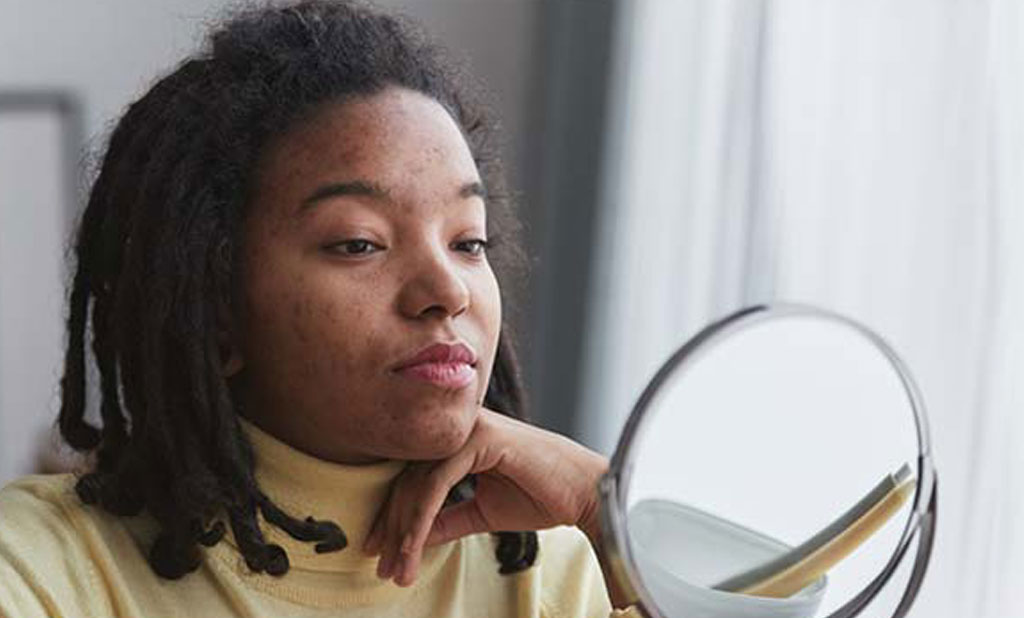Acne is considered one of the most common skin diseases worldwide. In this case, severe pimples, pustules, papules and blackheads form on the face of patients. Most often, the appearances occur on the forehead, cheeks and chin. However, the décolleté and back can also be affected. Not only the “acute” manifestations are disturbing for those affected – the “late effects” can also be, because scars often remain. In this article, we will show you how these acne scars can be removed and what options we offer you in our practice in Munich.
What is acne?
The culprit of acne is usually the blockage of the excretory ducts of the sebaceous glands – usually due to cornification. As a result, sebum builds up and blackheads form. If they rupture, they attract bacteria. These break down the sebum and produce cleavage products that promote inflammatory reactions. A short time later, a pimple usually appears on the affected area. The formation of new blackheads is also stimulated by this process.
Since impure skin typically occurs during puberty due to the changes in the body, teenagers are usually the ones who suffer. Since they are going through a formative, often difficult phase of their lives anyway, acne represents a further psychological burden for them.
What are the risk factors for acne?
- Androgens (male sex hormones)
- Overactive sebaceous glands
- Hormone fluctuations
- Wrong diet (dairy products, too much fat and sugar)
- Predisposition
- Severe psychological strain and stress
- Side effects of certain medications (e.g. cortisone, antibiotics, neuroleptics, psychotropic drugs)
- Anabolic steroids
Dr. Tatjana Pavicic
Dr. Tatjana Pavicic is a specialist in dermatology and venereology with her own practice in Munich. She is an internationally recognized expert in aesthetic dermatology with a special focus on dermocosmetics, botulinum toxin, fillers and lasers.
What types of acne are there?
“Common acne” (acne vulgaris) is the best known and most common form of acne. It is caused by hormonal changes during puberty.
It has three subtypes: The mildest form is acne comedonica, which affects only the face and is predominantly accompanied by blackheads. The moderately severe form is called acne papulopustulosa. Here blackheads and inflamed pimples appear. It is possible that not only the face, but also the décolleté and back are affected. Finally, there is the third and most severe form. In acne conglobata, nodules form on the skin. They become inflamed quickly and leave visible scars after healing. This severe form of acne can also manifest on the arms, abdomen, buttocks, and even the scalp.
In addition, there are other forms that arise from specific causes. These include contact, cosmetic or chlorine acne, medication acne or even doping acne. Furthermore, there are forms such as newborn acne, infant acne, Mallorca acne (sun eczema) and acne inversa (in the armpit and intimate area).
How do acne scars develop?
Acne scars and pimple marks may remain on the skin, especially in/after severe courses. They have arisen, e.g. because you wanted to squeeze out the blackheads and pimples yourself and were too ungentle in doing so. If the blemishes are not cleaned out professionally, fine veins, sebaceous glands and the surrounding tissue can be damaged or even destroyed. On the one hand, this can aggravate the acne symptoms, on the other hand, it can increase the risk of scarring.
Scars always form when the epidermis (the top layer of skin) has suffered damage and even deeper layers of skin are affected by the injury. In many cases, your body is then unable to restore the skin exactly as it once was. It replaces the wound with so-called granulation tissue. In this process, collagenous connective tissue fibers fill the wound from the inside. They close it and help restore the affected area of skin. In this way, the replacement tissue closes the injury, but this often remains visually visible in the long term.
What are the types of acne scars?
atrophe scares
They are also called ice pick scars. Atrophic acne scars occur when the wound does not heal properly and the body does not form enough connective tissue. Thus, the scar develops below the surrounding tissue and becomes visible as a small depression.
Hypertrophic scars
In this case, the skin or scar tissue is bulging. The skin has formed insufficient tissue where an inflamed pimple stood. Since it does not have the same structure as healthy tissue, it appears thicker and overlies the skin.
Keloid
In some cases, compared to the hypertrophic form, the acne scar continues to proliferate and extend into other areas of the skin. Keloids rarely occur in acne, but are still not uncommon.
What are the treatment options for removing acne scars?
In our private practice for dermatology and aesthetics in Munich, we offer various innovative therapies to remove your acne scars. These include:
Chemical peeling
Medical peeling relies on highly concentrated and effective acids. It stimulates natural skin renewal, increases skin metabolism and improves the appearance of the skin. In addition, it can shrink large pores and make the skin more resistant to external irritants. It is highly dosed and has a medical background. Therefore, the chemical peeling is not comparable to a treatment in a beauty salon.
Read more: Chemical peeling Munich
Lasemd
This is a unique combination treatment. With a laser and the corresponding cosmeceuticals, we can accelerate the self-healing of your skin from the inside out. With the specially developed active ingredients, we can reduce or even remove acne scars.
Further information: LASEMD Munich
Laser treatment
Acne scars usually respond very well to laser treatments. There are various therapies available here:
In fractional laser treatment, pulses are delivered to your skin at short intervals, causing micro-perforations on and under the skin. Between the minimal injuries, “islands” of unharmed skin remain. This stimulates your body to heal/close the tiny injuries again. As a result, it forms new collagen and elastic fibers. In this way, we can achieve a significant improvement in skin quality. This means that acne scars can be removed or reduced.
A very good way to remove acne scars is also ablative laser procedures. In this procedure, we remove the superficial layers of skin, creating a minimal wound on your skin. The body’s subsequent production of collagen and fresh elastic fibers helps treat acne scars.
More info: Laser treatment munich
Acne scar removal munich
Have you been left with unsightly scars from your acne condition that you would like to have removed? We understand well that acne scars can become a psychological burden. In our practice in Munich, we offer various therapies – depending on the condition, size and shape – with which we treat the acne remnants. Simply contact us and make an appointment for a consultation!
Foto: © seventyfourimages / elements.envato.com

